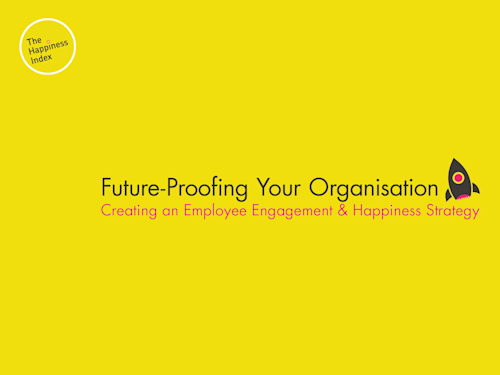
Creating an Employee Engagement AND Happiness Strategy
For many HR teams, diversity, equity and inclusion (DE&I) is a key topic of conversation and rightly so! We know that HR teams can’t always prioritise the work they want to do without buy-in from leadership and their organisation.
So let’s talk about why DE&I is important!
There are two aspects of DE&I that we’re going to cover in this article. The data behind why DE&I is important and the neuroscience aspect.
Many studies demonstrate that DE&I programmes are beneficial for your people, recruitment/retention rates and even your bottom line. But what exactly are the benefits of diversity, equity and inclusion in the workplace?
Companies with higher-than-average diversity had 19% higher innovation revenues. (Harvard Business Review)
The research tells us that diverse groups are more likely to be creative in their problem solving. This is because solutions are at their most creative when many different insights are combined to create something unique. By working with diverse team members a group is likely to lean towards complex ideas that provide holistic solutions. This will solve problems for everyone, rather than just a few!
Companies in the top-quartile for gender diversity on executive teams were 21% more likely to outperform on profitability and 27% more likely to have superior value creation. (McKinsey)
Neuroscientific research shows that gender diverse teams are more likely to include all participants. This means that one person is less likely to dominate the conversation and you’re more likely to reach solutions which work for the whole group. Although the McKinsey report was looking specifically at leadership groups, this study can (and should!) be applied more widely. Any group working towards shared goals will perform better when it is more diverse.
Cognitive diversity enhances team innovation by 20% (Deloitte)
Beyond gender and race, thinking about people with different educational backgrounds, as well as neurodiverse teams, can help innovation within your organisation. This is cognitive diversity. Teams which think differently will come up with different and unique solutions to problems. They will create products and processes which are beneficial to more people, and therefore more profitable!.
50% underrepresented employees stated that they see bias as part of their day-to-day work experience. (The Quantum Workplace)
Despite these facts about the effects of diversity on organisations’ bottom lines, we still see in research time and time again that employees face bias every day. It’s important to try to work to mitigate this for two reasons. Firstly, in order to retain talent, and secondly, to get the most out of your whole team. We will explore this further in the next section…
Within our Neuroscience model we rely on 8 neuroscience themes. One of the neuroscience themes that directly influences happiness in the workplace is Safety. (If you’re interested - don’t forget to check out why you should care about happiness in the workplace).
Safety is important in the workplace, because when people feel unsafe the basal part of the brain is activated. We sometimes refer to the basal part of the brain as the reptilian brain, because it’s the instinctive area which is associated with our fight or flight response. When people are in fight or flight mode, it hijacks their entire brain. This means that people who don’t feel safe aren’t able to work as productively, effectively or to as high a standard as they would otherwise.
We often link our vision of #FreedomToBeHuman with the safety neuroscience theme. This is because if people feel that they are able to bring their full human selves to work every day, whatever that means to them, their fight or flight response is less likely to be activated. This means they’ll be more able to produce great work and they’ll be happier.
But it’s not all about happiness. To perform at their best and thrive at work, your whole team needs to be engaged.
Enablement is a key theme here, this is because if you have a diverse team they’re going to have diverse needs. Ensuring everyone has the resources they need to succeed at their roles within your organisation will help everyone perform to the best of their abilities. Blanket solutions don’t work for diverse teams, because the needs of each individual will be unique. By giving people what they need to succeed, including a manageable workload for their circumstances, you’ll be able to make the most out of your team.
Part of giving your team what they need to succeed is also ensuring that they have sufficient opportunity to collaborate. As we’ve seen from the stats above, it’s this that really allows a diverse team to flourish. Particularly when it comes to creativity and innovation. Giving your team the opportunity, tools and environment in which they can work together is going to help your people and organisation to flourish.
Lastly, personal growth is another key area to consider when it comes to diversity, equity and inclusion in the workplace. In fact, it might be one of the most important points to consider! Ensuring that your whole team has the opportunity to grow, but also can see a diverse team modelled in their leadership team, will help you retain and attract the best possible talent. As we’ve seen in the studies outlined above, diverse leadership teams also lead successful organisations.
Our Equality of Voice survey allows you to benchmark and measure Diversity, Equity and Inclusion within your organisation. Plus our powerful data analytics and insight tools help you to identify key areas where you are performing well as well as where your organisation has room to improve.
This will help you build a workplace diversity, equity and inclusion strategy that will support your people, and your organisation as a whole.

Linked to Happiness & Engagement in our neuroscience methodology... learn more
The Happiness Index helps organisations measure the key employee engagement AND happiness drivers to power their people strategy.
Our unique platform offers the products, insights and tools to shine a light on your cultural health and empower management to drive thriving cultures.
Our neuroscience-based pre-built surveys measure the full employee experience - from onboarding to exit to empower and enable organisations to understand their people and create data-led action plans.
